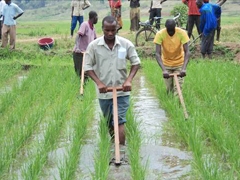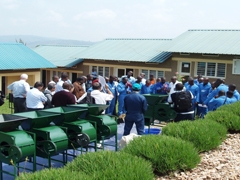A. NRDS Formulation
Rice is a priority food crop in Rwanda. With an average productivity of 5.8 t /Ha, rice is grown over 12,400 Ha of marshlands in two seasons which makes around 80,000 MT per year. Although there has been a rapid rise in rice production in the past decade, the country has not yet achieved self-sufficiency. Rwanda annually imports an average of 26,736 t of milled rice. Furthermore, the quality of locally produced rice lags behind that of imported rice. Thus Rwanda's rice sector is confronted with how to sustainably raise both the production and quality of locally grown rice to meet the consumer demands.
Through the coalition of rice development initiative, JICA Rwanda supported technically and financially the formulation of NRDS (National Rice Development Strategy 2010 - 2018)
B. PiCROPP (Project for increasing Crop Production with quality extension services in Eastern Province, Republic of Rwanda.) (Nov 2010 - Nov 2013)
The Republic of Rwanda has the highest population density of 380 persons /km2 in Sub-Sahara Africa, in which farmers are engaged in small-scale farming with averaged 0.76ha per farmhouse hold (hereinafter called as FHH). In addition, 80% of farmlands are 5 to 55 degree slanted. In the hilly area, low productivity and profitability are predominant Because of limited irrigation water, dependency on rainfall, and ineffective farming system.

Farmers applying weed control practices using farm implements introduced by PiCROPP
In lowland, where accessibility to irrigation water is relatively better compared with hilly Areas, paddy farming has been practiced and has higher potential to increase productivity, if proper water management and farming techniques are introduced. Under the condition, it is necessary to promote agriculture with higher productivity and profitability in order to cope with increasing population pressure in late years. For that purpose, it is required to develop capacities of agricultural workers, however, existing organizational system in the field level is insufficient, although restructure in the agricultural sector has been implemented such as structural reforming, organizing of farmers, and decentralization.
In November 2010, JICA started a technical cooperation project (PiCROPP) aiming to increase crop production by introducing improved farming techniques on the field through developing capacities of farmers , agricultural extension officers , related organization staffs. The project is being implemented in two districts of Eastern Province, Bugesera and Ngoma District. Project records shows that paddy production increased from the national average of 5.8 t/ha to 7-8t/ha in the project area.
Profitable horticulture production is also being implemented in the project area where farmers are more and more becoming market sensitive.
C. Supporting the analysis of rice mechanization enabling environment
Mechanization is a powerful tool in achieving sustainable agricultural production because it enhances human capacity with the potential beneficiaries being men and women farmers. It allows timeliness, efficiency and consistency in field operations.
Under the coalition for Africa rice development initiative (CARD), JICA is leading the discussion among stakeholders on enabling environment that the government can provide to easy mechanization business along the mechanization actors supply chain.

Local mechanization workshop trainees exhibiting their fabricated rice winnowers
In term capacity development JICA is also considering to dispatch a Japanese expert to assist the taskforce of irrigation and mechanization in planning and promoting mechanization journey of the Ministry of Agriculture and Animal Resource.






scroll